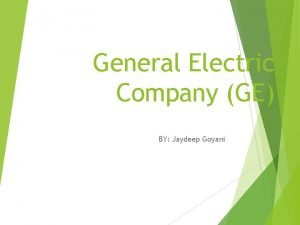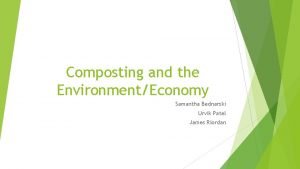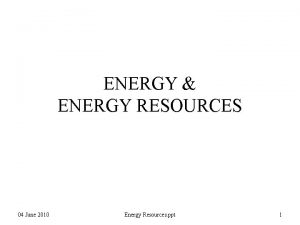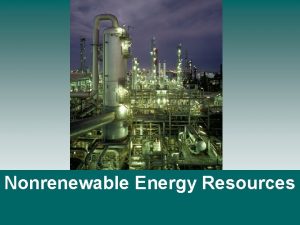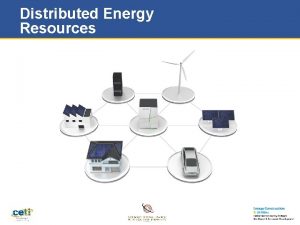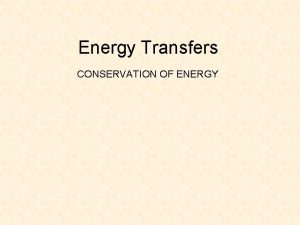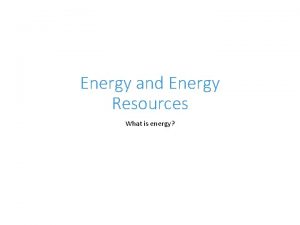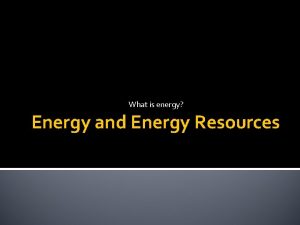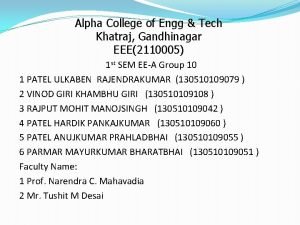ENERGY RESOURCES G H PATEL COLLEGE OF ENGG























































- Slides: 55

ENERGY RESOURCES G. H. PATEL COLLEGE OF ENGG. & TECH. (011), VALLABH VIDYANAGAR GUIDED BY PROF. SNEHAL POPLI CIVIL & STRUCTURAL ENGG DEPT

Group Members 29. YASH DALAL -130110119011 30. VINAY SUDANI- 130110119056 31. ARUN PATEL- 130110119035 32. PARIMAL PATEL - 130110119041 33. ADRIAN FERNANDIS- 130110119017 34. KARAN CHUNAVALA- 130110119009 35. PRATIK PARMAR- 130110119033

Introduction �Energy = Working capacity �All types of work like , pushing, pulling and etc �Forms of Energy Mechanical 2. Thermal 3. Chemical 4. Biological 1.

WORLD WIDE ENERGY SOURCES USE(2004) Series 1 40% 35% 30% 25% 20% 15% 10% 5% 0% R EA CL U EC EL RO YD H N TR IC AL CO S GA O IL Series 1

ENERGY RESOURCES COMMERCIAL & NON COMMERCIAL 2. PRIMARY & SECONDARY 3. CONVENTIONAL & NON CONVENTIONAL 4. RENEWABLE & NON RENEWABLE 1.

INDIAN SCENARIO �INDIA IS THE THIRD LARGEST PRODUCER OF COAL IN WORLD �IN INDIA , MANY TYPES OF COAL FOUND 1. GONDWANA 2. TERTIARY 3. LIGNITE �INDIA ALSO DEPANDS ON PETROLEUM AND NATURAL GAS

INDIAN SCENARIO COAL OIL �ITS CALORIFIC VALUE �IN INDIA OIL FIELDS IS 5550 KCAL/KG �THE COAL RESERVES OF INDIA ARE ESTIMATED ABOUT 110 MILLION METRIC TONES ARE DISTRIBUTED IN GUJRAT PLAINS , ASSAM , COASTAL STRIPS , ETC

GAS �A TOTAL OF 78. 4 BILLION CUBIC METERS CAN BE CONSIDERED AS PROVEN RESERVES WHILE A FIGURE OF 170 BILLION CUBIC METER CAN BE GIVEN AS PROBABLE RESERVES MAKING A TOTAL OF 293. 4 BILLION CUBIC METER OF GAS WHICH AMOUNTS 1. 5 BILLION TONES OF COAL EQUIVALENT.

CONVENTIONAL ENERGY SOURCE �COAL �PETROLEUM �NATURAL GAS �NUCLEAR ENERGY

ADVANTAGES OF CONVENTIONAL ENERGY SOURCES �EASY TO STORE �AVAILABLE IN HIGHLY CONCENTRATED FORM �RELIABLE SUPPLY �LOWER COST PER UNIT OF ENERGY PRODUCED AS THE TECHONOLOGY IS MATURED.

DISADVANTAGES �LIMITED SUPPLY AND WILL ONE DAY GET EXHAUSTED. �HIGH RUNNING COST �EXTRACTION OF FOSSIL FUELS CAUSE VARIOUS POLLUTION. �HIGHLY POLLUTING. �AVAILABLE IN FEW PLACES.

ENVIRONMENTAL IMPACT OF COAL BASED THERMAL POWER PLANT �Coal based power plants are the major source of air pollution and also a source for thermal pollution. �Coal are major contributors of green house gases and also pollutants responsible for acid rain.

Emission from thermal power plants � The main emission of coal are carbon dioxide, oxide nitrogen, sulphur dioxide, fly ash and also traces of radioactive elements. � Coal combustion is the emission of particulates that have serious impact on health. it can lead to increase problems like asthma, chronic, bronchitis, airway obstruction. � Coal also contains low levels of uranium, thorium and other radio active isotopes whose release environment leads to radioactive contamination. A 1000 MW coal based power plant could release as much as 5. 2 tons/year of uranium and 12. 8 tons/year of thorium.


ENVIRONMENTAL IMPACTS OF NUCLEAR POWER PLANTS �Nuclear power plants generate large amount of deadly radioactive waste. �Nuclear waste produce in power plant it can cause many problem of all organism. �All organisms are affected from the radioactive pollution. the effect may be somatic or grnrtic damage. The effect are cancer, shortening of life soan, mutation in the DNA, miscarriages, eye cataract etc.


NON-CONVENTIONAL ENERGY RESOURCES �Hydropower �Solar Energy �Wind Energy �Geo-Thermal Energy �Tidal Energy �Biomass Energy �Hydrogen Energy and Fuel Energy

ADVANTAGES OF NON-CONVENTIONAL ENERGY SOURCES �Wide availability �Decentralized power production �Available for the foreseeable future. �Lower running cost �Low pollution

DISADVANTAGES �Unreliable supply �Very difficult to store �Usually produce in small quantities �Currently per unit cost of energy is more compared to other types.


ADVANTAGES OF HYDROPOWER �Longer life �Minimum operating staff. �Can be started very quickly and stopped also. �Saves scarce fuel reserves �Non polluting and hence environmental friendly. �Low cost of generation and maintenance

PROBLEMS WHICH AFFECT THE HYDROPOWER GENERATION IN INDIA �Land acquisition �Environmental aspects �Rehabilitation �Seismic activity �Initial investment

SOLAR ENERGY � INDIA IS IDEAL COMBINATION OF SOLAR ENERGY AND ITS USE. � IN INDIA, THE DESERT OF GUJRAT IS MAIN PLACE FOR ACHIVING SOLAR ENERGY � THAR DESERT CAN GENERATE 700 GW – 2100 GW � INDIA WAS READY TO LAUNCH ITS NATIONAL SOLAR MISSION UNDER THE NATIONAL ACTION PLAN ON CLIMATE CHANGE WITH PLANS TO GENRATE 1000 MW OF POWER BY 2013. � THE AMOUNT OF SOLAR ENERGY IS PRODUCE IN INDIA IS LESS THAN 1% � HOWEVER , AS OF OCTOMBER 2009 INDIA IS CURRENTLY RANKED NO ONE ALONG WITH USA IN TERMS OF SOLAR ENERGY PRODUCTION PER WATT INSTALLED. � THE SOLAR ENERGY CONVERT INTO ELECTRIC ENERGY WITH THE TOOL OF SOLAR PANEL OF SOLAR CELL. � IT IS CONVENTIONAL ENERGY , RENEWABLE ENERGY AND POLLUTION LESS ENERGY


SOLAR ENERGY SYSTEM USE IN INDIA WATER HEATER(DOMESTIC) WATER HEATER 10000 SOLAR COOLERS 250000 SOLAR STILLS 10000 SOLAR HATS 200 5000

APPLICATION OF SOLAR ENERGY �Solar water heating. �Solar drying of agricultural and animal products. �Solar distillation. �Solar cookers. �Solar engines for water pumping. �Solar furnaces. �Solar green houses.

ADVANTAGES �Easy installation and maintenance. �Absence of noise and other form of pollution. �Long life of SPV systems make them favorable for use in remote and isolated areas, forest, hilly and desert regions.


LIMITATIONS �Amount of sunlight that arrives at the earth’s surface is not constant. It depends on location, time of day, time of year and weather conditions. �Uncertainty of availability of solar enengy due to clouds, wind, rainfall etc.

Power Towers Power tower in Barstow, California.

WIND ENERGY It Blows You Away �WIND ENERGY POTENTIAL , IN INDIA IS 25000 MW �ABOUT 6000 MW IS LOCATED IN TAMIL NADU AND 5000 MW IN GUJARAT


TYPES OF WIND MILLS �Multiblade type wind mill �Sail type wind mill �Propeller type wind mill �Savonius type wind mill �Darrieus type wind mill

ADVANTAGES OF WIND MILLS �Non polluting and environment. friendly source if energy �Important renewable and sustainable source of energy. �Generation period is low. �Cheaper. �Easily available in many off-shore , on-shore and remote areas.


LIMITATIONS �Low energy density. �Favourable in geographic locations which are away from cities. �Variable, unsteady, irregular, intermittent, erratic and dangerous. �Wind turbine design, manufacture and installation have proved to be complex due to widely varying atmospheric conditions. �Located only in vast open areas. �Economical only on a small scale.

BIO MASS ENERGY �Biomass , defined as living matter or its residues. �It includes all the new plant growth, residues and biodegradable organic effluents from industries like sugar , slaughter house, meat packing plants, distilleries etc.


Biomass resources fall into three categories: � 1) Biomass in its traditional solid mass (wood and agricultural residue) � 2) Biomass in non traditional from (converted to liquid fuels). � 3) To ferment the biomass anaerobically to obtain a gaseous fuel called biogas. � BIOGAS 55 to 65% CH 4 30 to 40% Co 2 Rest -- Impurities i. e. H 2 , H 2 S, N 2

�IN , INDIA BIO GAS PRODUCTION HAS BECOME VERY COMMON PARTICULARLY IN RURAL AREAS �A 100 KW GASIFIED SYSTEM HAS BEEN ESTABLISHED AT PORT BLAIR �A 10 MW RICE STRAW BASED THERMAL POWER PLANT HAS BEEN COMMISSIONED BY BHEL AT JHALKHARI IN PUNJAB.

SOURCES OF BIOGAS �Sewage �Crop residue �Vegetable residue �Water hyacinth �Poultry droppings �Algae �Ocean keep �Cattle waste

ADVANTAGES �Plants ensures a continuously supply of energy due to their continuous growth. �Potential for rural areas. �Biogas can be used for cooking purpose. �For operating small engines for pumping water. �For lighting. �Wastes can be used as an excellent fertiltzer.


LIMITATION OF BIOMASS ENERGY �Except biogas, the other biomass energy sources have to be establish a significant role.

GEO THERMAL Geothermal energy is the energy which lies embedded within the earths crust. There is an increase in temperature of the earth with increasing depth below the surface. All the heat is stored in the earth’s crust and thermal energy constitutes inexhaustible source of energy termed as geothermal energy.


2 Main uses of Geothermal Energy: Geothermal power plants are generally built where geothermal reservoirs are located with in a mile or two of the surface. 2. Geothermal heat pumps use stable ground or water temperature near the earth’s surface to control building temperatures above ground. 1.

TIDAL ENERGY � THE PERIODIC RISE AND FALL, CALLED A TIDE, CAN BE USED TO PRODUCE ELECTRIC POWER WHICH IN THIS CASEIS MKNOWN AS TIDAL POWER. � THE TIDAL POWER POTENTIAL IN INDIA IS ESTIMATED TO ABOUT 15000 MW � THE POTENTIAL SITES ARE GULF OF CAMBAY 7000 MW GULF OF KACHCHH 1000 MW AND SUNDERBANS 1000 MW � OTHER SUITABLE SITES ARE LAKSHADWEEP ANDAMAN & NICOBAR ISLANDS TAMILNADU , KERALA, ORISSA AND MAHARASHTRA.




PROBLEMS DUE TO OVERUSE OF ENERGY RESOURCES Due to population explosion, rapid industrialization and most importantly man’s unending desire to increase his comfort levels and living standards, the utilization rate of all the energy resources like coal, crude oil, etc is increasing by leaps and bound. This over use can cause some serious environmental, technological, economical and ecological problems.

IMPORTANT PROBLEMS DUE TO OVER USE OF ENERGY RESOURCES 1. 2. 3. 4. 5. Extinction of Resources. Excessive mining of minerals. Pollution. Economical Effect. Need of development of new technology.


 Engg2780
Engg2780 Civil house drawing
Civil house drawing Engg 1100
Engg 1100 Engg 1100
Engg 1100 Animals that eat both plants and animals
Animals that eat both plants and animals Jm patel college
Jm patel college Transformation process
Transformation process Fixed and variable resources examples
Fixed and variable resources examples Renewable vs nonrenewable resources worksheet
Renewable vs nonrenewable resources worksheet Energy energy transfer and general energy analysis
Energy energy transfer and general energy analysis Energy energy transfer and general energy analysis
Energy energy transfer and general energy analysis Bakersfield college human resources
Bakersfield college human resources Dr vikas patel
Dr vikas patel Dr vikas patel
Dr vikas patel Prashan patel
Prashan patel Dr niraj patel
Dr niraj patel Dr bhavesh patel
Dr bhavesh patel Jaydeep patel youtube income
Jaydeep patel youtube income Dr niraj patel
Dr niraj patel Dr megha patel
Dr megha patel Websoc uci
Websoc uci Guide planes in rpd
Guide planes in rpd Anisha patel family feud
Anisha patel family feud Bhavesh patel md
Bhavesh patel md Pendleton's rules
Pendleton's rules 138000/12
138000/12 A. d. patel
A. d. patel Dr bhavesh patel
Dr bhavesh patel Dr bhavesh patel
Dr bhavesh patel Laura patel
Laura patel Krunal patel md
Krunal patel md Life of pi true story
Life of pi true story Dr bhavesh patel dhoraji
Dr bhavesh patel dhoraji Dr nisha patel
Dr nisha patel Middle ear risk index
Middle ear risk index Kunal kotecha
Kunal kotecha Parveen patel
Parveen patel Ash patel md
Ash patel md Nisha patel md
Nisha patel md Uci webreg
Uci webreg Amirah shaikh
Amirah shaikh Nisha patel md
Nisha patel md Qa eic patel
Qa eic patel Fick ptt
Fick ptt Patel v r
Patel v r Dr bhavesh patel
Dr bhavesh patel Mitesh patel lhcb
Mitesh patel lhcb David siddhartha patel
David siddhartha patel Nisha patel md
Nisha patel md Gita patel life of pi
Gita patel life of pi Karsanbhai khodidas patel
Karsanbhai khodidas patel Fay patel
Fay patel Urvik patel
Urvik patel Data block
Data block Dr ebrahim patel
Dr ebrahim patel Riya patel quora
Riya patel quora

















